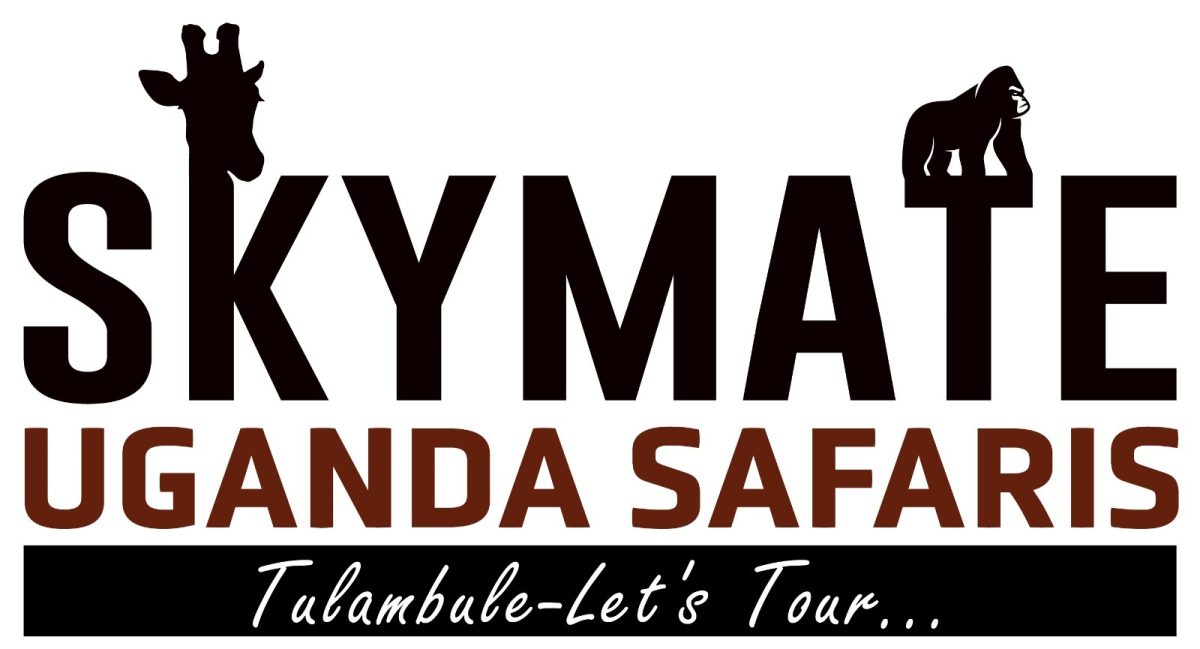Table of Contents
ToggleLocals still know it as Selous Game Reserve. But the official name is Nyerere National Park. Whatever you call it, this Tanzania safaris park is one of the largest in Africa, spanning almost 31,000 km²/12,000 square miles. This makes it similar in size to Belgium.
The national park’s landscapes are magnificent, offering a beautiful mix of the snaking Rufiji River, palm-fringed lakes, woodlands and deep gorges.
Nyerere National Park is home to the world’s largest populations of lions, buffalos, hippos, and African wild dogs. The park also offers refuge to many giraffes, crocodiles, elephants, and aquatic birds. It is the only Tanzania safari park where game drives are combined with walking safaris, boat tours and overnight fly-camping excursions.
Nyerere National Park also has a refreshingly wild feel about it. And it is nicely removed from the crowds that you often get in the Tanzania’s Northern safari circuit parks. In fact, this is one of few places in East Africa where you can enjoy the area famous safari trails in relative peace, and where each wildlife encounter still feels like a real discovery.
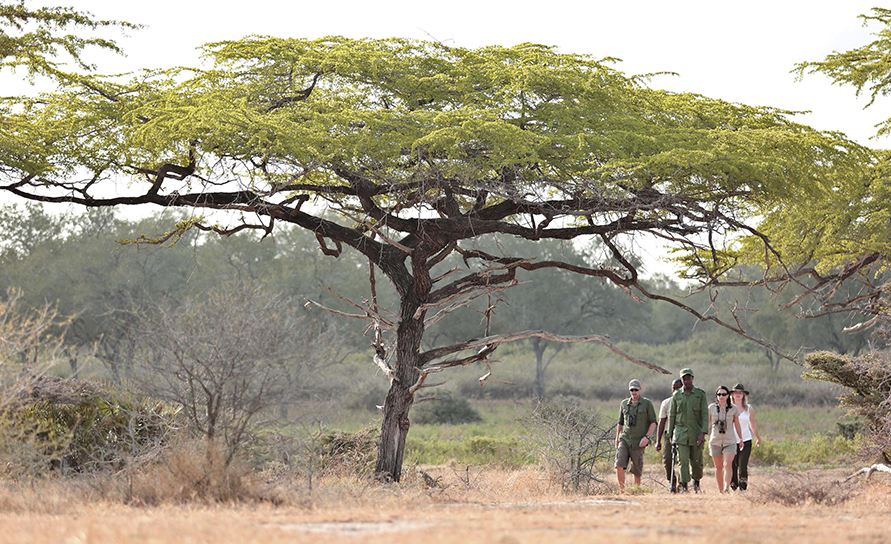
Why is it called Nyerere National Park?
Formerly called Selous, the park was renamed in honor of the late Mwalimu Julius Nyerere, the founder of the nation. In 2019, the now-deceased former president of Tanzania, John Magufuli, announced that the vast Selous Game Reserve would be split into two. The northern, southern, and western parts were designated as Nyerere National Park, but the eastern area remained the Selous Game Reserve.
Location & Size of Nyerere National Park
Nyerere National Park park is located in the remote southern region of Tanzania about (249 km) 155 miles southwest of Dar es Salaam. It is the largest national park in East Africa, covering an area of 30,893 km2 (over 3 million hectares) – nearly four times the size of the Serengeti National Park.
This massive conservation area protects a wonderful mix of Acacia savannahs, grasslands, miombo woodlands, marshes and riverine forests, characteristics that formerly warranted the Selous Game Reserve’s designation as a UNESCO World Heritage Site. To the east, the park continues as the much-reduced Selous Game Reserve, which nevertheless encompasses some 20,155km2 (around 2 million hectares) – nearly twice the size of Masai Mara in Kenya.
Nyerere is also adjoining Mikumi National Park in the northwestern corner, which, together with adjacent Udzungwa National Park, helps to connect the greater Selous ecosystem to the Ruaha ecosystem in the west.

River Rufiji in Nyerere National Park
Tanzania’s Nyerere National Park encompasses over three sides of the Rufiji River valley, including its tributaries such as the Ruaha River and Beho Beho River.
The picturesque Rufiji River – the largest river in Tanzania – dominates Nyerere’s landscape, plunging through Stiegler’s Gorge and finally fanning out into an intricate network of channels, oxbow lakes and marshes. At the height of the rainy season, Rufiji River becomes an angry torrent of brown water that changes the face of the landscape every year.
In the dry season, the river supplies a never-ending parade of thirsty wild animals of every shape and size, flock to the water’s edge and are provided with welcome shade by towering Borassus palms. Its waterways define the Nyerere safari experience, with game drives taking place along the banks and safari boat cruises across the interconnected lakes – providing a unique African safari alternative.
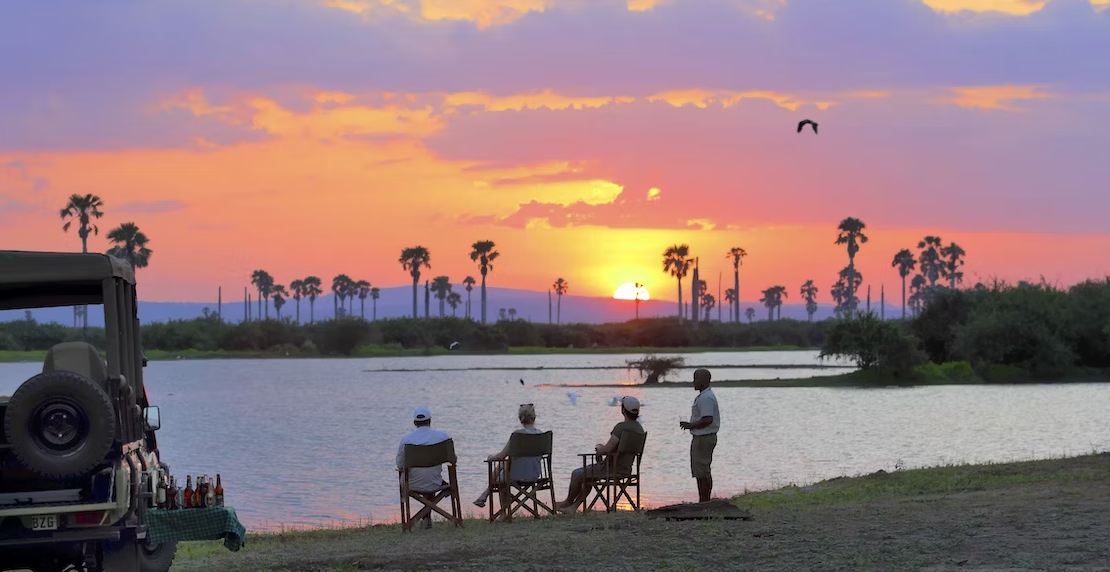
FAQS about Nyerere National Park Safari
1. How does a Nyerere safari compare to Serengeti?
The ideal scenario is a holiday in which you combine a safari in Nyerere National Park and the Serengeti National Park safari. That way you could compare these two magnificent Africa wildlife safari parks for yourself. At the highest level, both national parks have incredible wildlife and you’ll get to see the animals against a backdrop of gorgeous surroundings.
Looking a little closer, Nyerere National Park has much more water and subtropical vegetation, as well as denser woodlands. These landscape differences are also reflected in the subtle differences in the wildlife you can see here.
While there are several wildlife species that are common to both, such as big cats, elephants, zebras, giraffes, crocodiles and hippos, Nyerere has fewer plains species and is a crossover zone where you can see bird species from both East and southern Africa.
2. What can I expect from a Nyerere Park Safari?
You can expect to see lots of wildlife against a backdrop of spectacular landscapes when you are on a safari in Nyerere National Park. More precisely, the most exciting part of your holiday will be the early morning and late afternoon wildlife safari experiences.
Usually this means a before-dawn wake-up call, a hot drink, then a game drive looking for birds and animals. Unless you are moving on to a different location for the next night, you will return to camp mid- to late morning for breakfast and/or lunch.
This is often a time to relax, before afternoon tea and another game drive immediately afterwards. While out on the trail, just before sunset, you will most likely stop somewhere scenic for a sundowner where you can enjoy the drink of your choice at a simply gorgeous time of day.
In Nyerere National Park, there is one fine variation on this classic safari experience: instead of one or more of the game drives, you might go on a boat tour or safari out on the Rufiji River, from where you will get a whole new perspective on the national park.
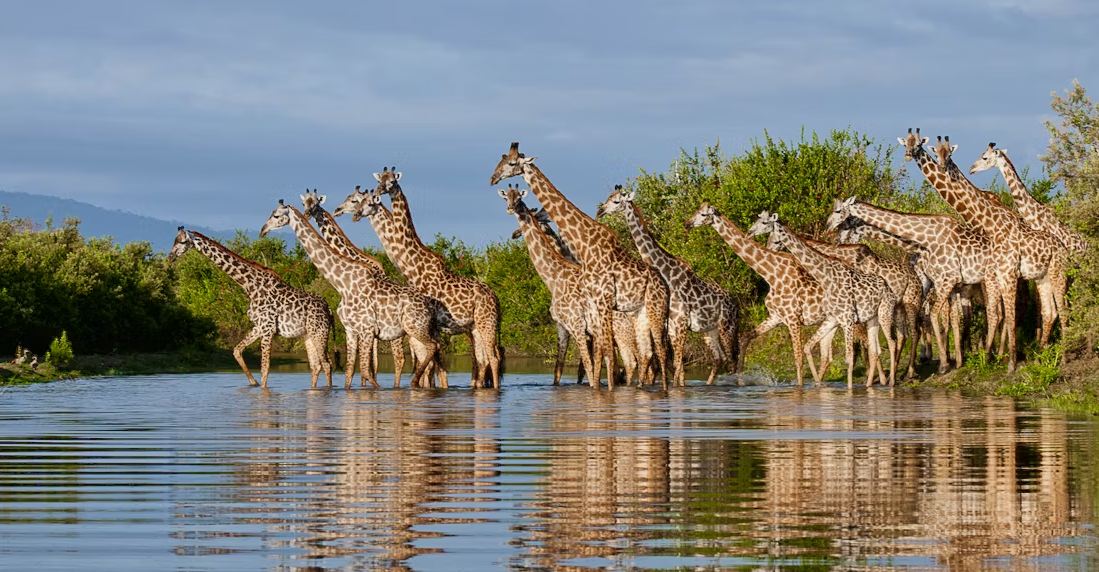
3. How much will a Nyerere National Park safari cost?
Prices vary widely when it comes to Nyerere safari packages, starting from around US$150 per person per day for the cheapest safari, up to over US$1,000 per person per day for the height of luxury.
At the cheaper end of the price range, you will most likely be sleeping in simple rooms or bungalows, possibly with shared bathrooms, or in camp tents. If you are on a camping safari, you might be expected to contribute to group chores, such as setting up camp and cooking. For mid-range wildlife safaris, you can expect rooms, meals and vehicles of a higher standard.
If your accommodation is in safari tents, you’ll have en suite bathrooms and a few other furnishings, with space to walk around in. At the luxury end of the scale, accommodation is superb and spacious, with high levels of personal service, excellent meals and less-crowded safari vehicles.

4. What animals are in Nyerere National Park?
Nyerere National Park has the advantage of having stunning scenery and wildlife habitat on both land and the Rufiji River. On a safari boat cruise out on the river, you will see hippos, crocodiles and abundant birdlife, and you never know which land mammals might come down to drink by the river’s edge.
On wildlife game drives, you are almost guaranteed to see both lions and elephants: the Nyerere National Park has some of the largest populations of both species in Tanzania. Other big cats are always a possibility, as are African wild dogs, and the national park has large populations of zebra, giraffe, buffalo, and wildebeest.
There so many other species including hyenas, rhinos, waterbuck, impala, hartebeest, Puku, the majestic sable and roan antelopes and the shy Suni. Also, more than 440 bird species have also been recorded in Nyerere, making this a top-notch destination for birders.
- Lions
- Leopards
- Elephants
- Buffalos
- Rhinos
- African wild dogs
- Spotted hyenas
- Cheetahs
- Hippos
- Crocodiles
- Zebras
- Giraffes
- Sable antelope
- Roan antelope
- The Puku antelope
- Common eland
- Coke’s hartebeest
- Wildebeest, etc

5. How many days are recommended for a safari in Nyerere National Park?
Spend as much time as you can in Nyerere. I would recommend a minimum of 3 days for a safari in Nyerere National Park. That will give you time to go on several game drives, take a Rufiji River safari boat cruise, enjoy more than one river sunset, and get a good overall experience of what this national park has to offer.
With just two days, you could achieve much of the same, but it will be a bit of a rush, and you will most likely leave wanting more. Each extra day you have here will bring rewards, allowing you to see more of the park and return to some of your favorite corners of the park.
Additional days also mean you can factor in relaxation time to enjoy your accommodation and downtime without feeling as though you’re missing out if you don’t go out and explore. Nyerere safaris are often combined with Ruaha or the more westerly Katavi and Mahale Mountains National Parks. This can result in a longer, more diverse itinerary of 8 days to 2 weeks.
6. What type of accommodation can I expect on Nyerere National Park safari packages?
While your Nyerere National Park safari takes you into pristine wilderness away from city life, you can still enjoy luxurious accommodation in such inaccessibility.
Nyerere has some amazing safari lodges and camps located in distinct areas of the park, some having won international awards. There is a fantastic range of choice from the ultimate in pampered safari luxury to the more authentic and simplistic.
In general, safari camps and lodges in Nyerere offer extremely high standards of personal service. Camps tend to be small, boutique-type properties that operate to the highest eco-friendly standards.
Mid-range properties have more lodge-like features and tend to be larger with swimming pools, spacious common areas and could even have purpose-built spas. All will keep you as close to nature as possible, in some cases only separated from it by canvas.
- Lake Manze Camp – Midrange
- Rufiji River Camp – Midrange
- Siwandu Camp – Luxury
- Selous Kulinda Camp – Midrange
- Selous Impala Camp – High end
- Sand Rivers Camp – Luxury
- Kiba Point – Luxury
- Beho Beho – Luxury
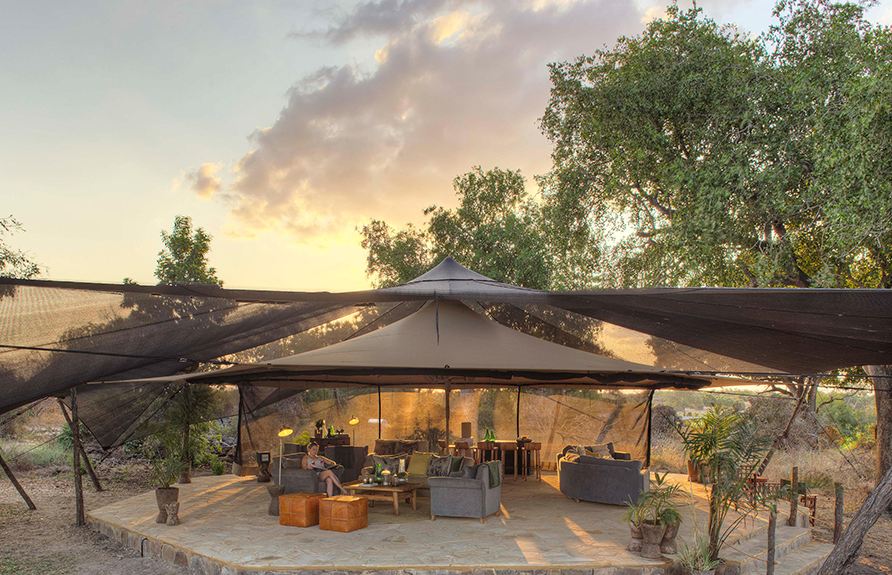
7. What is the best time to Visit Nyerere National Park?
June to October is the best time to be on safari in Nyerere National Park. During these months you can expect mild temperatures, clear skies and park trails that are easy to drive. May, November and December can also be good. At these times, rain is possible, although it’s rarely more than an afternoon shower or thunderstorm.
These months are also generally shoulder season, with lower prices, fewer safari travelers, and often greater availability when it comes to the busier camps. The rest of the year, from January to April, rains are more likely to disrupt your safari and some safari trails may be muddy and difficult to drive.
- June to October – best time
- May, November and December – good time
- January to April – rainy season
8. How to get to Nyerere National Park?
Nyerere National Park is easily accessible by air from Dar es Salaam, Tanzania’s largest city, with several flights per week landing at the park’s dedicated airstrips.
Once in the park, you can choose from a range of accommodation options, from luxury lodges to simple tented camps, all of which provide comfortable and convenient bases for exploring.
You can also reach Nyerere National Park by road. But there are few advantages to driving to Nyerere for a safari. It is a long, hot, dusty trip from Dar es Salaam. Flights to Nyerere provide a thrilling introduction to the reserve. The light aircraft sweeping above the Rufiji River provides good views of channels and islets teeming with hippos, elephants and waterfowl.
If Nyerere is part of a tour that includes the Southern and Western safari circuits, it is worth noting that these reserves are spaced very far apart. Getting between them by road involves some very long drives, again tipping the scale firmly in favor of flying.
9. Can i combine a Nyerere Safari with Zanzibar?
Combining time in the Spice Island of Zanzibar with a safari on the Tanzanian mainland is a fantastic thing to do. And there is no better place to take that safari than Nyerere National Park.
When you factor in the wonders of Zanzibar, from the history and architecture of Stone Town to its gorgeous beaches and glorious sunsets, and a classic safari experience in Nyerere, you have so much to look forward to. Zanzibar is easy to reach from Nyerere National Park.
Nyerere is one of the closest mainland parks to Zanzibar, and you may even find a direct flight. That means you can get to Zanzibar much quicker than you can to almost any other Tanzanian park. Because Zanzibar is an island, most travelers who go to and from the mainland fly between the two.
Flying is certainly the best option, because it gets you between Zanzibar and Nyerere in the quickest way possible: flying by the most direct route means you can wake up in Nyerere in the morning and be in Zanzibar by (or just after) lunchtime.
It is possible to go to the mainland by boat (either a 2-hour catamaran or 6-hour ferry ride. There are two reasons why you might consider traveling by boat: you are looking for a cheap and affordable safari (flying is expensive) and you have plenty of time to spare.

Ready to Book Your Nyerere National Park Tour?
One thing you won’t encounter in Nyerere is crowds of fellow travellers. The lodges and camps in Nyerere scattered around the park. They are all relatively small and intimate, enhancing that wild off-the-beaten-track vibe that this Tanzania’s Southern Circuit park is all about.
